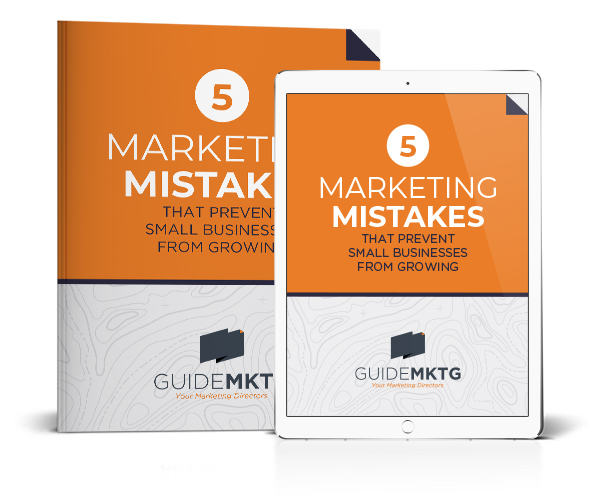Contrary to what many internet marketing gurus want you to believe, effective marketing campaigns don’t have to be complex or confusing. Straightforward marketing tactics are often the most effective. Take this simple marketing plan for small businesses, for example. Using a classic, five-part sales funnel, you can go from confused and overwhelmed to a successful business owner in just five steps.
What is a sales funnel?
A sales funnel is a marketing strategy used to attract potential customers and guide them through a cohesive customer journey.
The sales funnels we create for clients consist of five essential components:
- One-liner
- Website
- Lead generator
- Sales email sequence
- Ongoing nurture emails
We’ve seen this exact small business marketing plan work for local businesses and online businesses alike. We even use it for our own marketing agency.
Once this marketing strategy is in place, it becomes the solid foundation that amplifies any other marketing initiatives you add on. The best part is, once it is set up, the sales funnel can essentially run on auto-pilot.
All you’ll have to do is continually drive members of your target audience into your sales funnel to continue growing your business. You could use digital marketing like search-engine-optimized (SEO) blog posts to gain organic traffic, social media posts, or more traditional advertising methods like print ads and word of mouth. The sales funnel can then help you convert those leads into happy customers.
Implementing a sales funnel like this one will feel like you added a member to your marketing team. (One who works 24/7 and doesn’t collect a paycheck.) Your marketing budget will go further and your business goals will finally be within reach.
Simple 5-Part Sales Funnel for Small Business
Many small business owners find they already use pieces of this sales funnel in their marketing plan. Implementing this entire funnel will turn those disjointed marketing tactics into a cohesive marketing strategy that gets results.
Element #1: The One-Liner
Every business, big or small, needs a one-liner. A one-liner is a concise explanation of what problem you solve for clients, a brief description of what makes your solution unique, and an idea of what a client’s life could look like after they use your product or service.
This short paragraph is essential to business success because it:
- Forces you to define what you do, how you do it, and why it matters.
- Provides an easy way to explain your products or services to potential customers.
- Ensures everyone in your company talks about the business in the same way.
- Helps interested clients quickly decide if your product or service is right for them.
- Becomes the foundation of the rest of your marketing.
If you don’t currently have a one-liner for your business, use this step-by-step guide to write yours today.
Element #2: A Compelling Website
If you run a small business, you’ve probably already got a website. However, that doesn’t mean you get to immediately check this one off the to-do list. The real question is, is your website doing its job?
According to a study done by SWEOR about the importance of first impressions, 75% of consumers say that they use a company’s website to decide how credible the business is and 57% of people say they won’t recommend a company with a bad website.
Your website doesn’t exist just to give you a digital presence. It is an essential piece of your small business marketing plan. If your website isn’t helping you generate revenue or leads, it isn’t set up right.
Although design is important, the most crucial aspect of your website is clear messaging. Your website is an expanded version of your one-liner. You explain in detail the problem your ideal customer is facing, how your product or service can uniquely solve that problem, and then tell your target audience exactly how to get started.
To find out if your website is fulfilling its role in your small business marketing plan, show it to a stranger. Let them look at it for about 5 seconds and then ask them these three questions:
- What does this business do?
- How can it make your life better?
- How can you get what they offer?
If they can’t answer all three, it is time for a website makeover.
Every aspect of your website, from the words to the design, should be focused on speaking to your target audience and compelling them to take action. Whether they give you their email through a sign-up form, schedule a consultation, or buy a product, your website should be getting prospective clients to interact with your business in some way.
Element #3: An Irresistible Lead Generator
The third element of this simple marketing plan, a lead generator, is the key to bringing in new customers. A lead generator is something you offer for free in exchange for a potential client’s email address. This could be an ebook, free webinar, or any one of these 33 options.
The content should be directly related to the problem your company solves and catered to your target market. That way, the people opting in to get your freebie are already interested in what your business has to offer.
Once you have created your lead generator, you add a simple sign-up form to your website. Interested website visitors enter their email address to get the freebie sent to them. When someone opts in to receive your lead generator, they are also giving you permission to continue contacting them. This is when the funnel has the opportunity to really start working its magic.
Element #4: A Sales Email Sequence
After a potential customer has downloaded your lead generator, you set up your email management system to immediately send them a six-email sales sequence.
Many business owners are hesitant to immediately start selling to new leads. They are afraid they will drive them away. I can assure you that the problem isn’t selling to new leads. It is how you sell to them that will determine if they stick around or not.
This potential customer has a problem. You have the solution. Why wouldn’t you want to tell them about it right away?
If someone you’d just met had a headache and you had a bottle of pain relievers in your bag, would you offer it to them? Of course you would.
When done right, selling to new potential clients right away isn’t sleazy. It is helpful.
Write your sales email marketing campaigns with that mentality and you won’t scare anyone away. Your goal is to offer and educate potential clients about your solution, not force a sale.
For additional guidance on what to include in your sales email marketing sequence, follow this six-email formula.
Element #5: Useful On-going Nurture Emails
Although many people will be ready to take advantage of your solution right away, others may not. That is where nurture emails fit into the marketing plan.
Sending regular, ongoing nurture emails allows you to continue building a trusting relationship with your target audience. Each nurture email should provide valuable information or resources that potential and existing customers can use to solve a piece of their pain point.
Getting valuable information from you builds credibility and trust. Seeing your small business name regularly in their inbox reminds potential customers that you are still around to solve their problem. Occasionally, you should also use your nurture emails to remind them to buy the solution your company offers.
Not sure what else to write in your nurture emails? Here’s an easy way to plan a year’s worth of ideas in an hour or less.
The Easiest Way to Implement This Small Business Marketing Plan
If you’re ready to use a successful marketing plan and grow your business but don’t have time to do all of this work, schedule a call with Guide MKTG today.
We will write, design, and can even help you set up your entire sales funnel. Plus, we can partner with you on an ongoing basis to create content marketing that continuously draws new leads into your sales funnel.
As your marketing guide, we will ensure that you never waste good money on bad marketing again. Instead, you’ll have a growing business thanks to a simple marketing plan that actually works.





